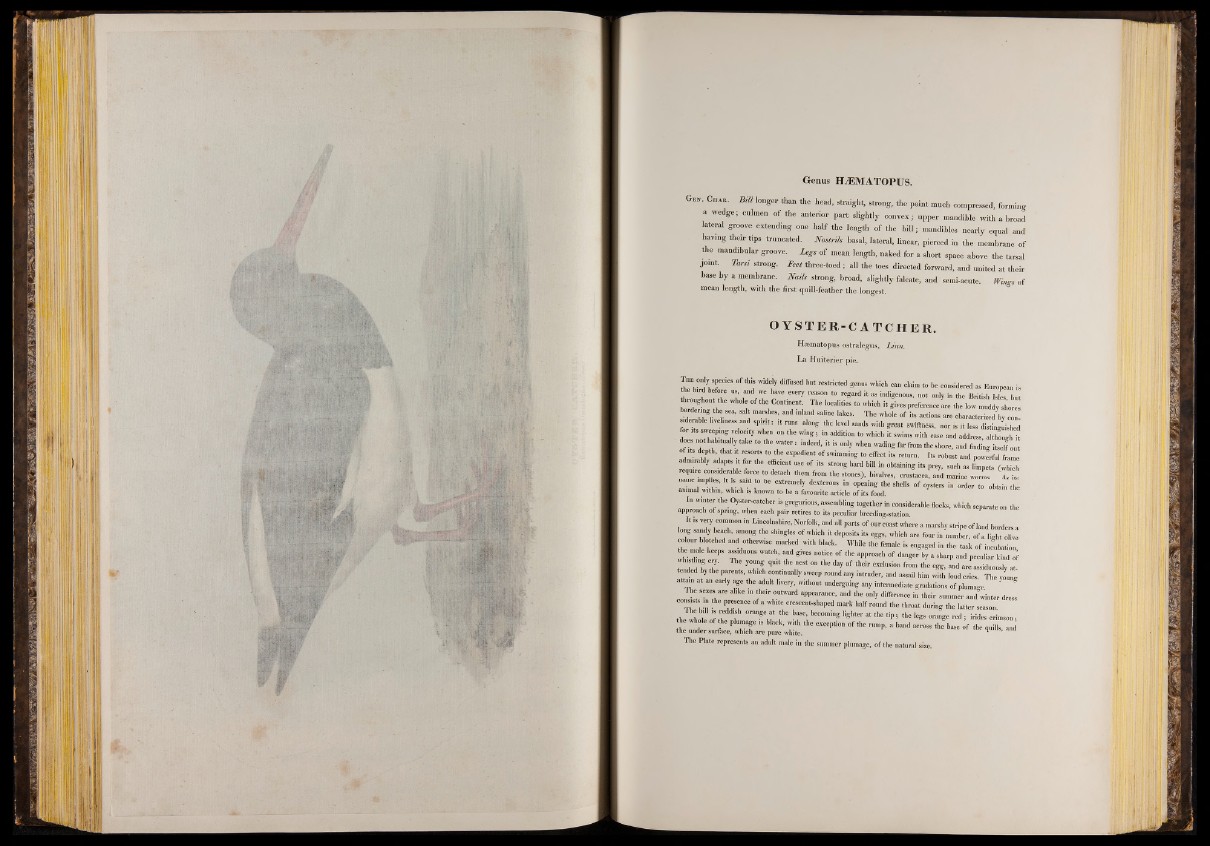
* •
Genus IIA5MATOPUS.
G *x. Chae. B ill longer than the head, straight, strong, the point much compressed, forming
a wedge; culmen of the anterior part slightly convex; upper mandible with a broad
lateral groove extending one half the length of the bill; mandibles nearly equal and
having their tips truncated. Nostrils basal, lateral, linear, pierced in the membrane of
the mandibular groove. Legs of mean length, naked for a short space above the tarsal
joint. Tarsi strong. Feet three-toed ; all the toes directed forward, and at their
base by a membrane. Nails strong, broad, slightly falcate, and semi-acnte. Wings of
mean length, with the first quiU-feather the longest.
OYS TER-CAT CHER.
Hasmatopus ostralegus, Linn.
La Huiterier pie.
The only species o f this widely diffused but restricted genus which can claim to be considered as European is
he bird before us and we have every reason to regard it as indigenous, not only in the British Isles but
throughout the whole o f the Continent. The localities to which it gives preference are the low muddy shores
bordering the sea, salt marshes, and inland saline lakes. The whole o f its actions are characterised by con-
fo t ,,''d l" eSSiand SP1" , ! * the level sands with great swiftness, nor is it less distingLhed
for its sweeping velocity when on- the w in g ; in addition to which it swims with ease and address, although it
does not habitually take to the water: indeed, it is only when wading far from the shore, and finding itself out
o f its depth that it resorts to the expedient o f swimming to effect its return. Its robust and powerful frame
admirably adapts it for the efficient use o f its strong hard bill in obtaining its prey, such as limpets (which
require considerable force to detach them from the stones), bivalves, c ru sL e a " and marine worms Is t
name imp hes, it is said to be extremely dexterous in opening the shells o f oysters in order to obtain the
animal withm, which is known to be a favourite article o f its food.
In winter the Oyster-catcher is gregarious, assembling together in considerable flocks, which separate on the
approach o f spring, when each pair retires to its peculiar breeding-station.
It is very common in Lincolnshire, Norfolk, and all parts o f our coast where a marshy stripe o f land borders a
ong sandy beach, among the shingles o f which it deposits its eggs, which are four in number, o f a light olive
colour blotched and otherwise marked with black. While the female is engaged in the task of
the male keeps assiduous watch, and gives notice o f the approach o f danger by a sharp and peculiar k' d°” r
whistling cry. The young H the nest on the day o f g j exclusion M M M M B m i M
tended by the parents, which continually sweep round any intruder, and assail him with loud cries The y L g
attam at an early age the adult livery, without undergoing any intermediate gradations o f plumage
The sexes are alike in their outward appearance, and the only difference in their summer and winter dress
consists m the presence o f a white crescentshaped mark half round the throat during the latter season
— | radd‘ sh H at tbe basc’ b<*o”d “g % bter at the tip; the legs orange red ; irides crimson •
he whole o f the p l u m y ts black, with the exception o f the rump, a band across the base o f the quills, and
the under surface, which are pure white.
The Plate represents an adult male in the summer plumage, o f the natural size.